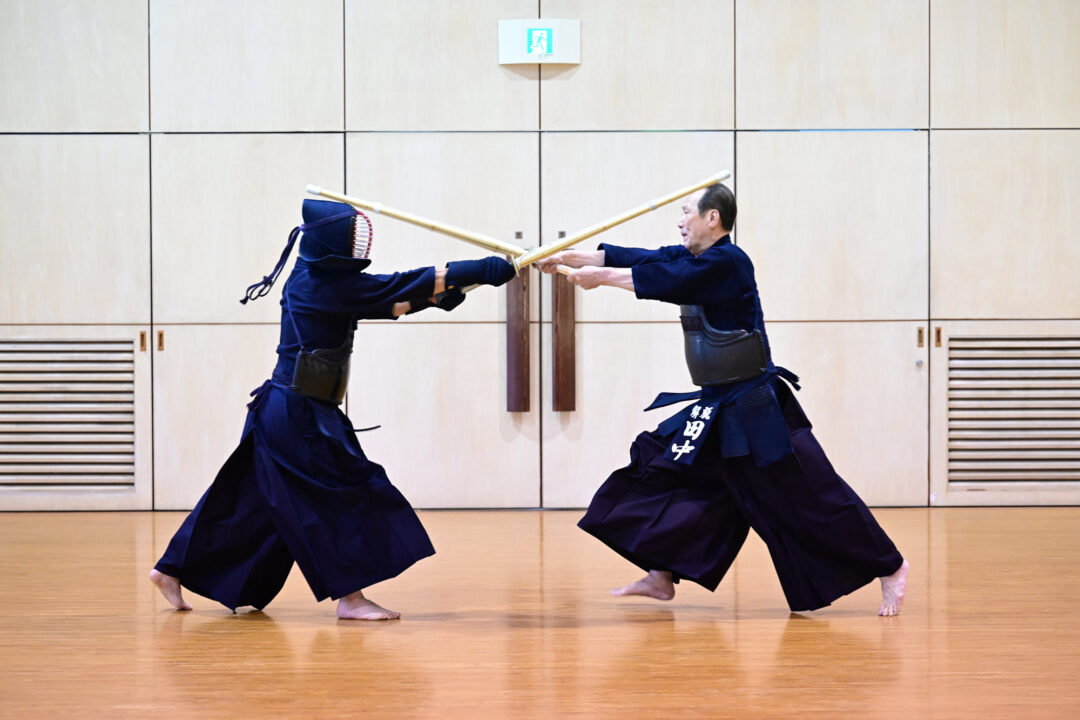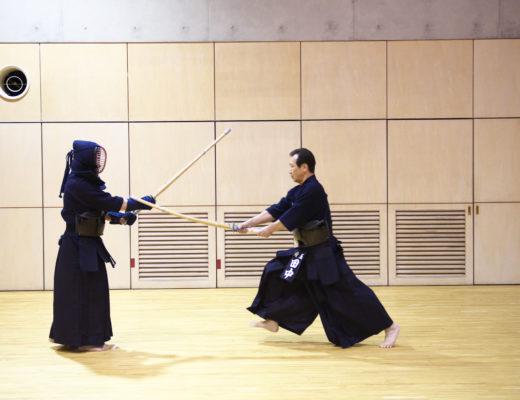2023.10 KENDOJIDAI
Photography: Nishiguchi Kunihiko
Composition: Tsuchiya Tomohiro
Translation: Jouke van der Woude
A strike after applying Seme can be countered or dodged. However, by applying Seme and Tame, you can make your opponent linger in their spot or draw them in, increasing the success rate of your strikes. With the ability to apply Tame, the scope of Kendo broadens, generating strikes which are followed through with*. We received an explanation from Kyoshi 8th Dan Tanaka Hiroaki, the director of Gedatsu Renshinkan, which has produced numerous Kendo practitioners and instructors, from young children to adults.
*follow-through is referred to as “Uchikiri” in Japanese
Tanaka Hiroaki, Kyoshi 8th Dan
Born in 1958 in Saga Prefecture, Japan. He attended Kokushikan University after graduating from Saga Kita High School. After graduation, he served in Gedatsu-kai. Currently, he serves as the director of Gedatsu Renshinkan. His notable achievements include winning and being the runner-up in the All Japan Interprefecture KENDO Championship, as well as participating in the All Japan TOZAI-TAIKO (East VS.West Japan) KENDO TAIKAI. As an instructor, he has led individuals to achievements such as 3rd place in the All Japan Kendo Training Championship for elementary school students and runner-up in the Mito National Championship for elementary school students.
Tame of both energy and feeling in the lower abdomen
First, when we think about the original meaning of the word Tame, it implies accumulating, like gathering water in a bucket. When I think about Tame in the context of Kendo, it means storing energy in the lower abdomen.
From the moment you rise from Sonkyo, it is crucial to gather and store your energy in the lower abdomen to establish a solid Kamae. When talking about Kamae, people often talk about a good Kamae or dignified Kamae, or that you can tell someone’s strength by their Kamae. To me, a good Kamae is one where there is Tame of energy in the lower abdomen.
During mutual Seme, as the Maai between you and your opponent shortens, both you and your opponent become more tense. Amidst this, by applying Tame and storing energy or feeling in your lower abdomen, you can relax the upper body and confront the situation with a composed mindset.
The late Hanshi 9th Dan instructor Narazaki Masahiko, who served as the second honorary director of our Dojo used to say, “Apply Tame, Tame, Tame.” He was a teacher who could deliver impressive Men-strikes that captivated everyone. He believed that one needed to apply Tame in order to bring out the best technique and fully unleash it in a natural way. This explosiveness creates follow-through. If you hesitate or feel intimidated by your opponent, you won’t be able to generate such striking power. If we were to make an analogy in baseball, it would be like a batter waiting patiently to fully connect with a fast ball thrown with maximum effort by the pitcher and then delivering the best swing. That kind of follow-through in Kendo is akin to hitting a home run.
In Kendo, the dynamics are different because you are in contact with your opponent, and the situation can change from moment to moment. Considering these aspects, if you just apply Seme and strike without considering the situation, you might land your strike but you might get countered as well. In other words, relying on luck to perform a strike is an unreliable situation in the context of Kendo, which originated from life-and-death encounters. It follows that what should be considered has been developed through the experiences and observations of our ancestors.
Apply Tame and get into Aiki to sense the opportunity for strikes
First and foremost, it can be said that getting into Aiki (a synchronous state with the opponent) is crucial. If you apply Seme and Tame, but do not get into Aiki with your opponent, the outcome of the duel remains uncertain. By getting into Aiki with your opponent, you can perceive their mental state, such as surprise, fear, suspicion, doubt (also known as Kyoku Giwaku), or sense when they linger in place. Striking at that moment brings about more certainty and leads to strikes that are followed through with. It is often said to “apply Seme and win, strike the opponent overwhelmingly” This concept is closely related to Tame.
There are various ways to apply Tame, and different situations call for different methods. You may apply Tame while applying Seme, and strike from there, or apply Tame and draw the opponent out before striking. The patterns are not uniform. During Keiko and Shiai, these mental processes should occur naturally.
When instructing someone to strike Men five times, beginners often finish quickly, while advanced practitioners take more time. The difference lies in whether they are consciously considering the dynamics of applying Seme and Tame. By being conscious of Tame, Kendo opens up to various techniques, including strikes from Seme, strikes from Tame, and drawing the opponent out through Tame.
As an insight from the teachings of our ancestors, we can refer to a theory from the writings of Edo-period swordsman Yagyu Munenori in his work called “Heiho Kadensho” also known as “The life-giving sword. In that passage, the idea of drawing the opponent out to strike them is somewhat synonymous with the concept of Tame.
I apologize for that complex explanation, but to create your own Tame, I believe it’s essential to repeatedly practice basic Keiko such as Kirikaeshi and Uchikomi while also engaging in Keiko with higher-ranked Sensei. Through this process, you will naturally learn to store energy through Tame in your lower abdomen.
In recent times, there is a trend where younger individuals tend to focus too much on winning. While this is necessary in Shiai, in regular Keiko, some individuals excessively raise their Shinai or focus on avoidance, with the intention of not getting struck. Such actions can cause a lot of confusion at lower striking speeds. I believe there are individuals who participate in the All Japan Kendo Championship and are active in the police force who you admire. They have been practicing meticulously from a young age, establishing a solid foundation in Kendo. Just trying to imitate them based on their prowess in Shiai without understanding the fundamentals won’t lead to the same results because their core is different. Therefore, young practitioners in particular need to be cautious.
For adults who start Kendo later in life, the number of basic exercises they’ve done may differ from those who have been practicing since childhood. However, adults often have the advantage of understanding and thinking through the basics, which can lead to Tame. During Keiko with high-ranking Sensei, focus on engaging in a sincere contest, applying Seme and Tame, and executing strikes with follow-through consciously. Naturally, you will be countered and struck. But getting struck is an opportunity for reflection. Learn from your Sensei’s spirit, Tame, timing, and breathing, as well as seizing opportunities to strike, and strive to make them your own.
Especially in high-level Dan examinations, even if you apply Seme and strike the target area, it won’t be appreciated if your approach is whimsical. The expectation for high-level practitioners, that is, instructors, is to synchronize their spirit with any opponent when putting their Kendo into practice.
The rest of this article is only available for Kendo Jidai International subscribers!



